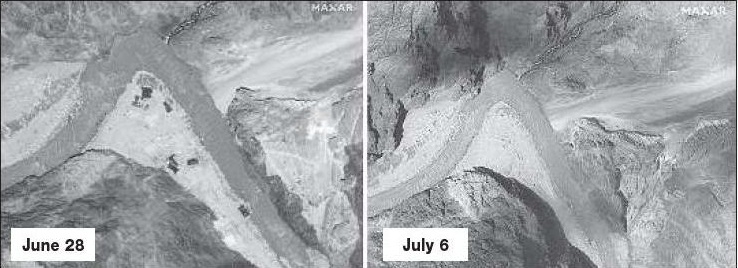China withdraws more troops, removes structures
| Date :08-Jul-2020 |

Images taken on June 28, July 6 show China appears to have dismantled recent construction in the Karakoram mountains in Galwan Valley. (AP/PTI)
NEW DELHI,
CHINESE military removed temporary infrastructure and continued gradual withdrawal of troops from face-off sites in Hot Springs and Gogra in eastern Ladakh for the second consecutive day on Tuesday, and the Indian Army is keeping a strict vigil on their rearward movement, Government sources said. Gogra and Hot Springs are among the key friction points where the two Armies were in an eyeball-to-eyeball situation for the last eight weeks.
The sources said the mutual disengagement of troops at the two friction points is likely to be completed within two days, and that there has been “substantial” withdrawal of forces by Chinese military from the areas. The sources said the Indian Army is not lowering its guard in view of the disengagement process in the area and will continue to maintain high-level of alertness to deal with any eventualities. They said the two two Armies are expected to hold further talks later this week after the first phase of disengagement process is completed. As per the decisions arrived at corps Commander-level talks on June 30, the two sides would create a minimum buffer zone of three kilometer in most of the areas where they were locked in a standoff.
“There has been substantial withdrawal of Chinese troops from Hot Springs and Gogra. The Chinese mliitary has dismantled temporary infrastructure too in the areas,” said a source. The Chinese military has already removed tents and withdrew its personnel from patrolling point 14 in Galwan Valley, the sources said adding the Indian Army is carrying out a thorough verification of the Chinese pull back. On the situation in Pangong Tso, they said a “marginal thinning out of troops” has been observed in the area. The Indian and Chinese Armies are locked in the bitter standoff in multiple locations in eastern Ladakh for the last eight weeks. Both sides have held several rounds of diplomatic and military talks in the last few weeks to ease tension in the region. However, there was no visible sign of any end to the standoff till Sunday evening.

Apache attack helicopter at a forward airbase near India-China border carried out night operations, on Monday. (ANI)
IAF intensifies night patrolling
NEW DELHI,
July 7 (Agencies)
IN A demonstration of its aerial prowess, the Indian Air Force is carrying out night-time combat air patrols over the mountainous eastern Ladakh region as part of its decision to maintain a high-level of readiness notwithstanding disengagement of troops by China from a number of friction points in the area, Government sources said on Tuesday. The IAF has also pressed into service a fleet of C-17 Globemaster III transport aircraft as well as C-130J Super Hercules in transporting heavy military equipment and weaponry to several forward bases to further ramp up India’s military preparedness in the region.
The IAF is also using its Ilyushin-76 fleet to transport troops to various areas along the LAC, the 3,500 km de-facto border between India and China, the sources said. They said the force has already moved a sizeable number of its frontline Sukhoi 30 MKI, Jaguar, Mirage 2000 aircraft to several key air bases including Leh and Srinagar.
It has also deployed Apache attack choppers and Chinook heavy-lift helicopters to transport troops to various forward locations. The frontline fighter jets have increased their sorties in Ladakh and nearby areas. Notwithstanding the strong winds and the chilling weather, the ground crew and pilots are flying using even very small windows when the wind speed is low.
The pilots of the Apache choppers could be seen flying with their night vision goggles which allows them to navigate through the mountains around the airbase and the dark night. The Chinook with its high tech gadgets and navigation aids is fully ready for 24x7 operations and played a big role in transferring troops to the Line of Actual Control from rear locations. The late-night operations started with the thundering noise of take-off of MiG-29 fighters which have been at the forefront of high-tempo operations after the hostilities broke out on the LAC. With its after-burners employed, the high-speed take-off roared over the high mountains around the airbase. The frequency of day and night operations is a signal that India will continue to put pressure on China until the status quo ante is restored in all the areas in Pangong Tso, Gogra and Hot Springs, they said.